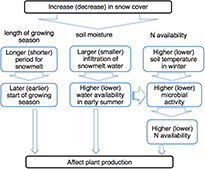** Progress in Earth and Planetary Science is the official journal of the Japan Geoscience Union, published in collaboration with its 50 society members.
Gallery View of PEPS Articles
Research
Biogeosciences
202201202201
Effects of snow manipulation on larch trees in the taiga forest ecosystem in northeastern Siberia
Shakhmatov R, Hashiguchi S, Maximov T, Sugimoto A
Boreal forest, Taiga, Larch, Snow manipulation, Permafrost, Stable isotopes, Phenology, Nutrient, Soil Moisture
(Upper) Schematic diagram on the effect of changing snow cover depth. Start of growing season, soil moisture and nitrogen availability may change following increase or decrease in snow cover depth, and affect plant productivity.
(Lower) Needle growth shown as percentage of needle length at final observation date (July 8, 2016) in each plot.
Changes in winter precipitation (snow) may greatly affect vegetation by altering hydrological and biochemical processes. To understand the effects of changing snow cover depth and melt timing on the taiga forest ecosystem, a snow manipulation experiment was conducted in December 2015 at the Spasskaya Pad experimental larch forest in Eastern Siberia, which is characterized by a continental dry climate with extreme cold winters and hot summers. Variables including soil temperature and moisture, oxygen and hydrogen isotope ratios of soil moisture and stem water, foliar nitrogen and carbon contents and their isotopes, phenology, and soil inorganic nitrogen were observed at snow removal (SNOW−), snow addition (SNOW+), and CONTROL plots. After snow manipulation, the soil temperature at the SNOW− plot decreased significantly compared to the CONTROL and SNOW+ plots. At SNOW− plot, snowmelt was earlier and soil temperature was higher than at other plots during spring because of low soil moisture caused by less snowmelt water. Despite the earlier snowmelt and higher soil temperature in the SNOW− plot in the early growing season, needle elongation was delayed. Leaf chemistry also differed between the CONTROL and SNOW− plots. The needle nitrogen content in the SNOW− plot was lower in the middle of July, whereas no difference was observed among the three plots in August. The soil inorganic nitrogen content of each plot corresponded to these results. The amount of soil ammonium was lower in the SNOW− plot than in the other plots at the end of July, however, once production started in August, the amount of soil ammonium in the three plots was comparable. Extremely low soil temperatures in winter and freeze–thaw cycles in spring and dry soil condition in spring and early summer at the SNOW− plot may have influenced the phenology and production of soil inorganic nitrogen.







